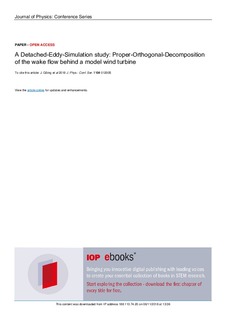| dc.contributor.author | Göing, Jan | |
| dc.contributor.author | Bartl, Jan Michael Simon | |
| dc.contributor.author | Mühle, Franz Volker | |
| dc.contributor.author | Sætran, Lars Roar | |
| dc.contributor.author | Thamsen, Paul Uwe | |
| dc.date.accessioned | 2018-12-11T09:07:51Z | |
| dc.date.available | 2018-12-11T09:07:51Z | |
| dc.date.created | 2018-11-06T19:46:21Z | |
| dc.date.issued | 2018 | |
| dc.identifier.citation | Journal of Physics, Conference Series. 2018, 1104 . | nb_NO |
| dc.identifier.issn | 1742-6588 | |
| dc.identifier.uri | http://hdl.handle.net/11250/2577049 | |
| dc.description.abstract | In times of intense renewable energy development, the planning of wind farms and the improvement of their total efficiency has become a major field of research. A precise analysis of the velocity deficit, fluctuation load and the wake properties behind a turbine is essential to identify the optimal positioning and control of a wind farm cluster. Due to the increasing computer performance, numerical models have become an important tool for the precise analysis of the turbulent wake flow and for the optimization of the positioning of the turbine in a wind farm. In this study the wake characteristics are calculated with a Delayed-Detached-Eddy-Simulation (DDES) using a sliding mesh technique. The simulation is based on a 3D model wind turbine with a diameter of 0.89 m and a test area which corresponds to the wind tunnel geometry at the Department of Energy and Process Engineering at NTNU. A validation of DDES with an experimental Laser-Doppler-Anemometry (LDA) matches well with the results of the simulation. Furthermore, the coherent motions of vortex shedding in the near wake are detected with the Proper-Orthogonal-Decomposition (POD) technique while the significant frequencies are detected with a Power-Spectral-Density (PSD). These quantities describe the transition from coherent to turbulent motions in the wake and explain the influence of the downstream flow in detail. The investigation shows that the DDES computations are able to accurately predict the mean and turbulent wake flow behind a model wind turbine. | nb_NO |
| dc.language.iso | eng | nb_NO |
| dc.publisher | IOP | nb_NO |
| dc.rights | Navngivelse 4.0 Internasjonal | * |
| dc.rights.uri | http://creativecommons.org/licenses/by/4.0/deed.no | * |
| dc.title | A Detached-Eddy-Simulation study: Proper-Orthogonal-Decomposition of the wake flow behind a model wind turbine | nb_NO |
| dc.title.alternative | A Detached-Eddy-Simulation study: Proper-Orthogonal-Decomposition of the wake flow behind a model wind turbine | nb_NO |
| dc.type | Journal article | nb_NO |
| dc.type | Peer reviewed | nb_NO |
| dc.description.version | publishedVersion | nb_NO |
| dc.source.pagenumber | 10 | nb_NO |
| dc.source.volume | 1104 | nb_NO |
| dc.source.journal | Journal of Physics, Conference Series | nb_NO |
| dc.identifier.doi | 10.1088/1742-6596/1104/1/012005 | |
| dc.identifier.cristin | 1627724 | |
| dc.description.localcode | Content from this work may be used under the terms of theCreative Commons Attribution 3.0 licence. Any further distribution of this work must maintain attribution to the author(s) and the title of the work, journal citation and DOI. Published under licence by IOP Publishing Ltd | nb_NO |
| cristin.unitcode | 194,64,25,0 | |
| cristin.unitcode | 194,64,91,0 | |
| cristin.unitname | Institutt for energi- og prosessteknikk | |
| cristin.unitname | Institutt for bygg- og miljøteknikk | |
| cristin.ispublished | true | |
| cristin.fulltext | original | |
| cristin.qualitycode | 1 | |

